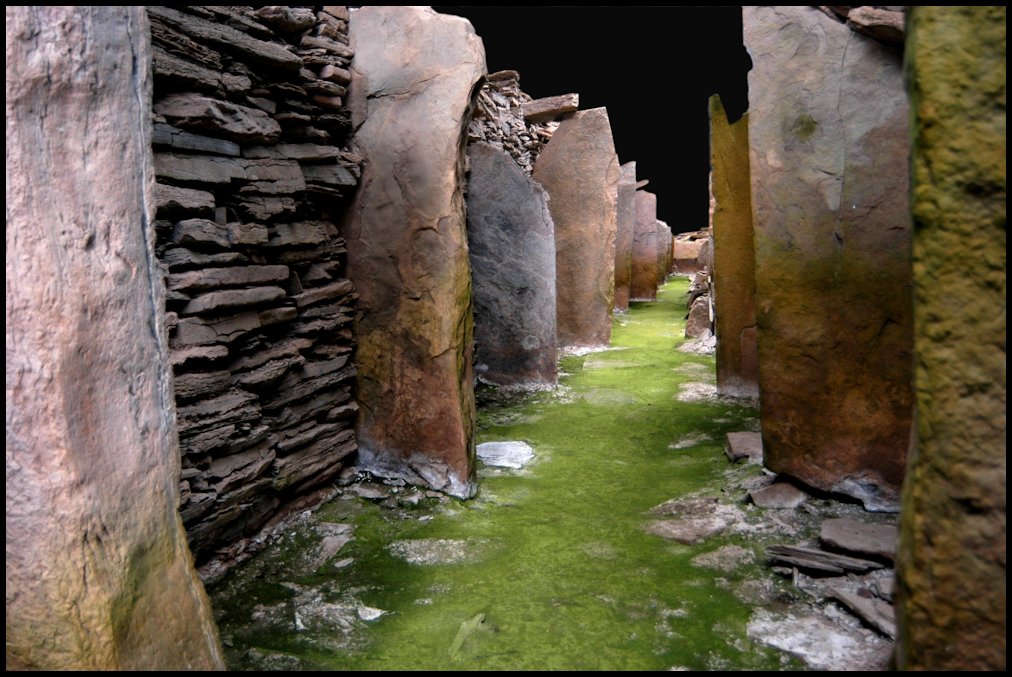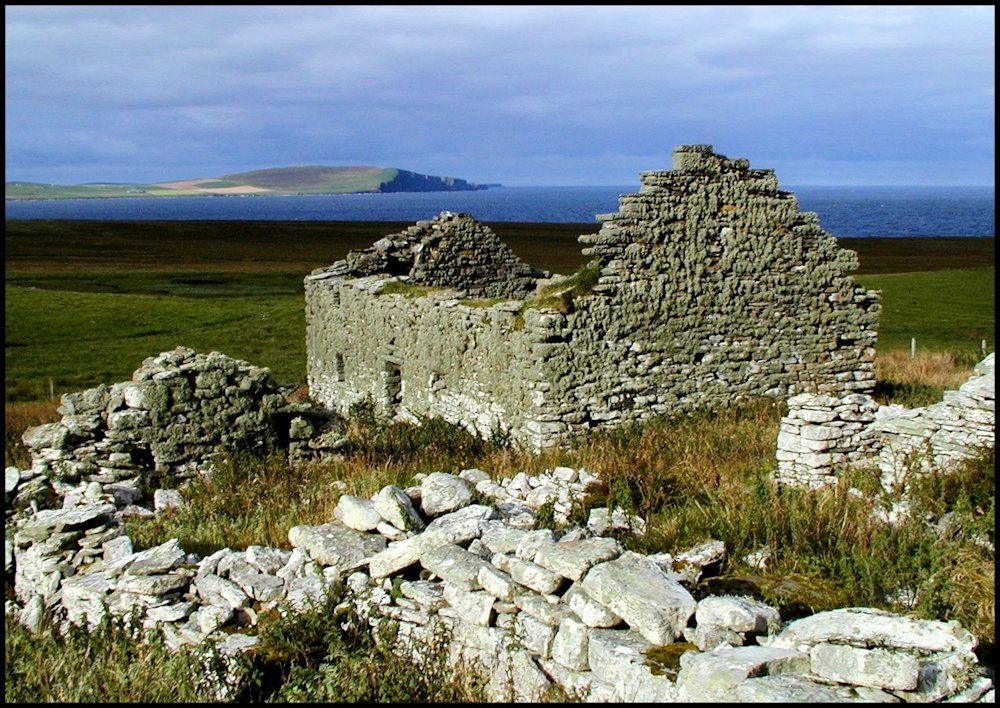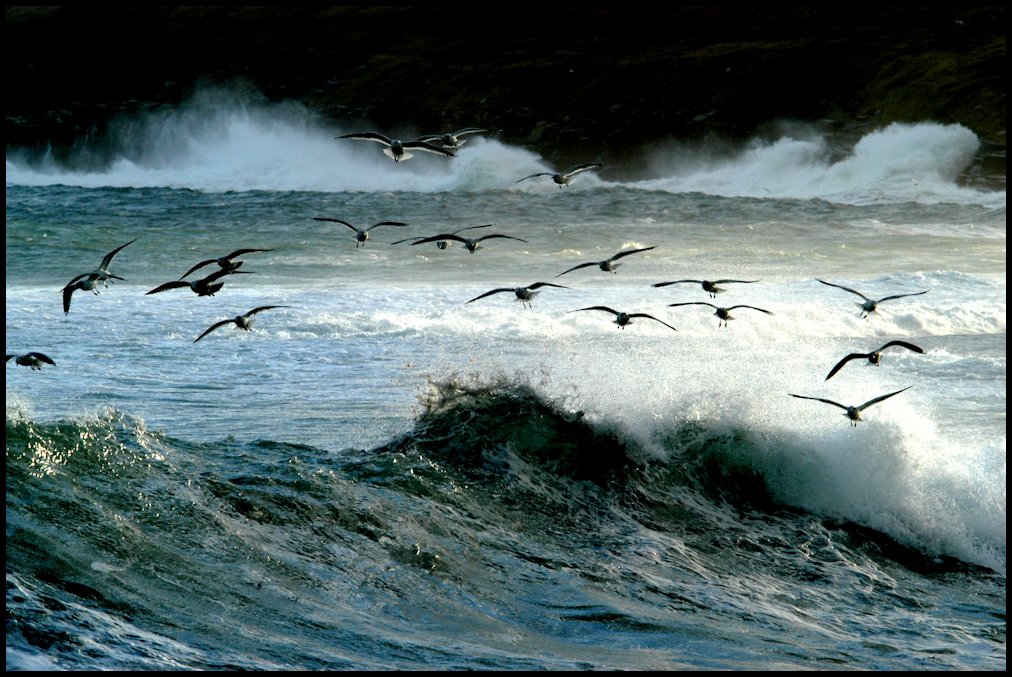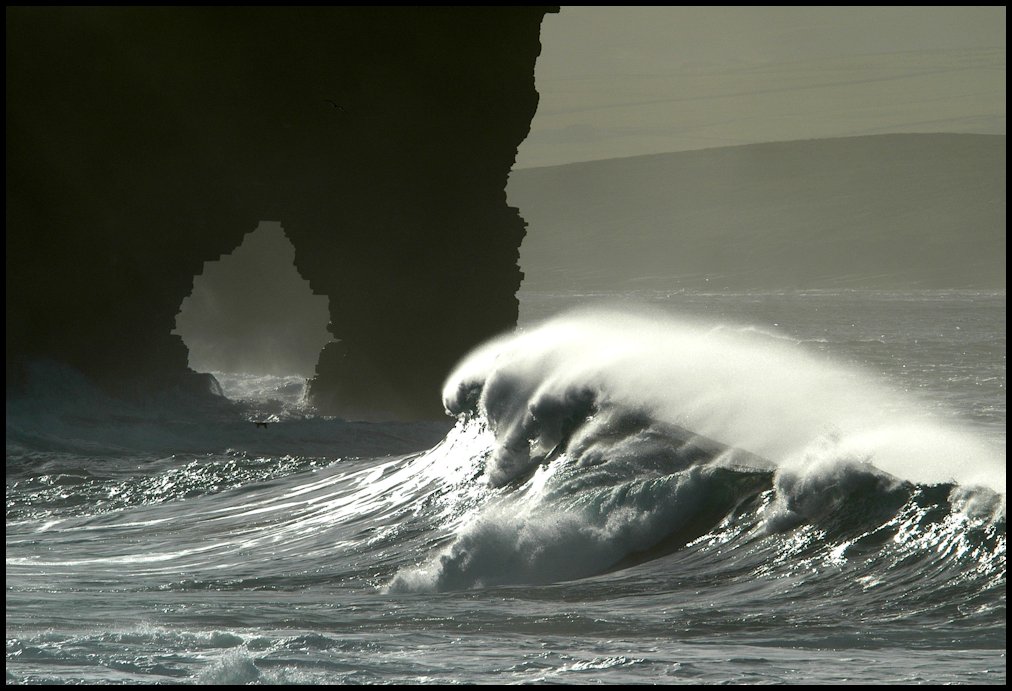Amidst the great tides of the Atlantic and the North Sea lies an Orkney island steeped in ancient history. From the Stone Age to the present, the seas have brought to Rousay a blend of peoples who have left a calendar of their lives for all to see. Having been inhabited for over 5,000 years there are over 166 sites of archaeological interest and an important crofting history. The island provides as rich a spectrum of settlement as can be found anywhere in Northern Europe, with evidence of Neolithic, Stone and Bronze Age, Pictish, and Viking habitation.
Much of the island has been officially designated as a Site Of Special Scientific Interest. The moors are inhabited by birds such as the Red-throated Diver, Hen Harrier, Buzzard, and Merlin, while its maritime heaths are home to colonies of Arctic Tern and Arctic and Great Skua. The northwest coast has a range of dramatic cliff formations with considerable colonies of Guillemot, Razorbill, Puffin, Kittiwake and Fulmar.
Pictured below: Primula scotica – which grows in only very selected places on Rousay. and a Red-throated diver, also known as the Loon or Rain Goose.
Quandale and Westness were the only areas in Orkney to have suffered a major Clearance. In the mid-19th Century 210 people were evicted by George William Traill as part of the modernisation of his Westness estate. Succeeded by his nephew General Sir Frederick William Traill Burroughs it was he who created such difficulties for the crofters that he gained the reputation as being the worst landlord in Orkney. His efforts resulted in troubled times and shaped the recent history of the island. Within this wild and open landscape of Quandale are found the relics of turf dykes, runrig farming and ruined crofts. This deserted community is now home for some of Rousay’s most rare and beautiful flowers and birds.
Rousay is undoubtedly one of the most picturesque islands in Orkney. Even today the greater part of its surface is covered with heather, and in the early days it can have offered but few attractions to the primitive agriculturalist in comparison with the lower-lying and more fertile islands of the group. Round the skirts of the isle, however, there are signs of cultivation from very far-off days; nor are indications lacking that the island was inhabited thousands of years earlier still – for how long exactly it is impossible to say, but a good idea of how long can be gained from the memorials left behind by these nameless folk of long ago.
To be able to understand who these people were and where and how they lived we owe much to the efforts of Walter Grant, who lived at Trumland House in the 1930’s. His investments in the whisky industry enabled him to invite some of the most influential archaeologists of the time to excavate the island’s sites – the Neolithic chambered cairns of Taversoe Tuick, Blackhammer, and the Knowe of Yarso, and Midhowe Cairn, the largest and longest of Orkney’s chambered cairns, which like the others dates from the 3rd millennium B.C. Just beyond that is the Broch at Midhowe, the best of a range of fortified dwellings built along the shore of Eynhallow Sound dating from the Bronze/Iron Age.
When the Neolithic settlement of Rinyo, near the farm of Bigland, was excavated it was found to be similar to Skara Brae, with at least seven houses. Like the more famous village, the houses had stone drains, fireplaces, beds and boxes. Now back-filled, only a few upright stones and drystone walls are visible today.
The Westness area of Rousay has been described as ‘the most important archaeological mile in Scotland,’ for it spans settlements from the first Stone Age farmers, the Pictish Iron Age, the Viking invaders, the period of the Earls of Orkney, through to the mid-19th century clearances when 210 people were evicted from Westness and Quandale by the laird, George William Traill.
According to an old Rousay legend, when the first Norsemen came to the island they were confronted at landing by strange elf- or troll-like beings who marched down against them – armed with glittering spears. In such a curious fashion has been perpetuated the first meeting of the Norsemen with the alien Celtic race.
Who the first Viking to set foot on Rousay was, we do not know. One would be compelled to identify Rolf (Hrølfr) whose name is commemorated in the name of the island – Rousay, Hrølfsey – with Torf Einar’s half-brother of that name – Rolf the Ganger, who founded the Norse power in Normandy, but there can be no justification in doing so. It is known that he went from Norway to the Hebrides and could well have visited Orkney en route, but it is probable that Orkney was settled some generations at least before the great Viking age, and that had begun nearly a century before his day.

Head, en route to Ireland – July 2007.
Besides the unknown Rolf, the names of a few other early settlers may be deduced from some of the farm-names in Rousay. The present farm-name Innister appears to be a corruption. The name does not appear in any of the early rentals, but in a deed of 1664 we find Rowland Insgaire in Insgaire. In the Valuation of 1653, this man evidently appears again as Roulland Ingsgarth. In a deed of 1671 the name appears as Ingsgair, and even as late as 1799 Innisgir in Wasbister is found in the Register of Births. By some strange accident the house name has now become Innister and the surname Inkster. The original form is doubtful, but almost certainly the first syllable represents a personal name.
Above: Both sides of the Hole o’ the Horse, Scabra Head
A clue to the original form of Hurtiso, a farm name in Sourin, is to be found in the 1492 Rental where Hurtiso, in Holm, appears as Thurstainshow – which translates to Thorstein’s mound.
The first syllable in Knarston is almost certainly also a personal name. In most cases in Orkney tunship-names, the termination –ston, which represents the dative plural of staðr, a stead, settlement, ‘tun,’ is suffixed to a man’s name, and this is unlikely to be an exception. There are two names suitable – Knorr and Narfi – and, as old forms of the name regularly show the initial K-, the former is to be preferred – Knarrar-stoðum, the settlement of Knorr.
Avalshay appears in both the 1500 and 1595 Rentals as Awaldschaw. The first part of the name represents a man called Augvald, and judging by the analogy of Horraldshay in Firth, which the 1500 Rental spells Thorwaldishow, and the Rental of 1595 Horraldsay and Horraldshay, we conclude that the Rousay name has been Augvaldshaugr, Augvald’s mound.
Lastly, in Frotoft, we have a form that points to an earlier Froða-topt, the site of a house of a man named Froði.
These four men – Froði, Augvald, Knorr, and Thorstein – were in all probability among the earliest Norse settlers in Rousay. They may even have been among those who, when landing, were challenged by the ‘glittering spears’; but to us today, none of them is more than a pale shadow of a name.
Knowledge of the tunship settlements in Orkney is largely derived from the old Rentals. These Rentals were primarily tax-rolls showing the various skats or taxes due to the Earls or Bishops from each farm or tunship, and in addition, in the case of property lands belonging to the earldom or bishopric, the annual rents due from the tenants in occupation.
From these Rentals we note that Orkney lands were valued in terms of early Norse money as ouncelands and pennylands. The old Norse silver mark (actually a weight – about ½ lb.) was sub-divided into 8 ounces and in Orkney the ounce was divided again into 18 pennies. Thus we find Orkney lands valued as urislands (i.e. ouncelands, from the Old Norse øyrir, ounce) and pennylands – 1 urisland consisting of 18 pennylands.
Outer Westness included Brugh – a 7d. land; Skaill, a 5d. land; Whome (Quham) a 3d. land; and Quandale, a 3d. land – in all, one whole urisland.










